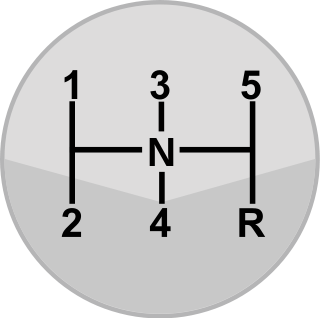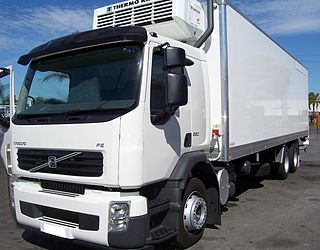Double-clutching is a method of shifting gears used primarily for vehicles with an unsynchronized manual transmission, such as commercial trucks and specialty vehicles. While double clutching is not necessary in a vehicle that has a synchronized manual transmission, the technique can be advantageous for smoothly downshifting in order to accelerate and, when done correctly, it prevents wear on the synchronizers which normally equalize transmission input and output speeds to allow downshifting.

An automatic transmission is a multi-speed transmission used in motor vehicles that does not require any input from the driver to change forward gears under normal driving conditions. Vehicles with internal combustion engines, unlike electric vehicles, require the engine to operate in a narrow range of rates of rotation, requiring a gearbox, operated manually or automatically, to drive the wheels over a wide range of speeds.

Overdrive is the operation of an automobile cruising at sustained speed with reduced engine revolutions per minute (RPM), leading to better fuel consumption, lower noise, and lower wear. The term is ambiguous. The most fundamental meaning is that of an overall gear ratio between engine and wheels, such that the car is over-geared, and cannot reach its potential top speed, i.e. the car could travel faster if it were in a lower gear, with the engine turning at higher RPM.

A transmission is a mechanical device which uses gears to change the speed or direction of rotation in a machine. Many transmissions have multiple gear ratios, but there are also transmissions that use a single fixed gear ratio.

A manual transmission (MT), also known as manual gearbox, standard transmission, or stick shift, is a multi-speed motor vehicle transmission system, where gear changes require the driver to manually select the gears by operating a gear stick and clutch.
A semi-automatic transmission is a multiple-speed transmission where part of its operation is automated, but the driver's input is still required to launch the vehicle from a standstill and to manually change gears. Semi-automatic transmissions were almost exclusively used in motorcycles and are based on conventional manual transmissions or sequential manual transmissions, but use an automatic clutch system. But some semi-automatic transmissions have also been based on standard hydraulic automatic transmissions with torque converters and planetary gearsets.

Hydramatic is an automatic transmission developed by both General Motors' Cadillac and Oldsmobile divisions. Introduced in 1939 for the 1940 model year vehicles, the Hydramatic was the first mass-produced fully-automatic transmission developed for passenger automobile use.

TorqueFlite is the trademarked name of Chrysler Corporation's automatic transmissions, starting with the three-speed unit introduced late in the 1956 model year as a successor to Chrysler's two-speed PowerFlite. In the 1990s, the TorqueFlite name was dropped in favor of alphanumeric designations, although the latest Chrysler eight-speed automatic transmission has revived the name.
Ford-O-Matic was the first automatic transmission widely used by Ford Motor Company. It was designed by the Warner Gear division of Borg Warner Corporation and introduced in 1951 model year cars, and was called the Merc-O-Matic when installed in Mercury branded cars and Turbo-Drive when installed in Lincoln branded cars. In contrast to Detroit Gear Division's three band automatic originally designed for Studebaker which became superseded by this unit, a variation of Warner Gear's three-speed unit named Ford-O-Matic continued to evolve later into Cruise-O-Matic named transmissions in 1958 and finally the FMX named transmissions in 1968. This line continued in production until 1980, when the AOD was introduced. Like Ford, variations of this same Borg Warner design were used by other automobile manufacturers as well, such as AMC, International Harvester, Studebaker, Volvo and Jaguar, each of them having the necessary unique adaptations required for the individual applications.

A direct-shift gearbox is an electronically controlled, dual-clutch, multiple-shaft, automatic gearbox, in either a transaxle or traditional transmission layout, with automated clutch operation, and with fully-automatic or semi-manual gear selection. The first dual-clutch transmissions were derived from Porsche in-house development for the Porsche 962 in the 1980s.

A preselector gearbox is a type of manual transmission mostly used on passenger cars and racing cars in the 1930s, in buses from 1940-1960 and in armoured vehicles from the 1930s to the 1970s. The defining characteristic of a preselector gearbox is that the gear shift lever allowed the driver to "pre-select" the next gear, usually with the transmission remaining in the current gear until the driver pressed the "gear change pedal" at the desired time.

The automated manual transmission (AMT) is a type of transmission for motor vehicles. It is essentially a conventional manual transmission equipped with automatic actuation to operate the clutch and/or shift gears.

A gear stick, gear lever, gearshift or shifter, more formally known as a transmission lever, is a metal lever attached to the transmission of an automobile. The term gear stick mostly refers to the shift lever of a manual transmission, while in an automatic transmission, a similar lever is known as a gear selector. A gear stick will normally be used to change gear whilst depressing the clutch pedal with the left foot to disengage the engine from the drivetrain and wheels. Automatic transmission vehicles, including hydraulic automatic transmissions, automated manual and older semi-automatic transmissions, like VW Autostick, and those with continuously variable transmissions, do not require a physical clutch pedal.

The Volvo FL is a series of trucks manufactured by Volvo Trucks. It was introduced in 1985 and has remained in production ever since, in a variety of different models of different weight ratings. It has been used in a variety of different roles aside from a truck, including as a fire engine.

The Volvo FE is a medium duty truck produced by Volvo Trucks Corporation since 2006, now in its second generation. The FE is available in various rigid versions and a tractor version spanning three weight classes.
Twin Clutch SST is the brand name of a six-speed dual-clutch automatic transmission, developed by Getrag for Mitsubishi Motors. The system was first incorporated in the 2008 Lancer Evolution X, and was designed to be a more performance-oriented system than that developed by rival manufacturers, with shorter gear ratios optimized for acceleration.
The Ford PowerShift is a six- or seven-speed dual-clutch automatic transmission, produced by the Ford Motor Company. The older Ford PowerShift gearboxes were built by Getrag Ford Transmissions, a joint-venture with Getrag, however it is unknown who exactly makes the newer 7-speed models. PowerShift improves fuel efficiency by as much as 10 percent when compared to a conventional automatic transmission.

A dual-clutch transmission (DCT) is a type of multi-speed vehicle transmission system, that uses two separate clutches for odd and even gear sets. The design is often similar to two separate manual transmissions with their respective clutches contained within one housing, and working as one unit. In car and truck applications, the DCT functions as an automatic transmission, requiring no driver input to change gears.

A motorcycle transmission is a transmission created specifically for motorcycle applications. They may also be found in use on other light vehicles such as motor tricycles and quadbikes, go-karts, offroad buggies, auto rickshaws, mowers, and other utility vehicles, microcars, and even some superlight racing cars.

A drivetrain is the group of components that deliver mechanical power from the prime mover to the driven components. In automotive engineering, the drivetrain is the components of a motor vehicle that deliver power to the drive wheels. This excludes the engine or motor that generates the power. In marine applications, the drive shaft will drive a propeller, thruster, or waterjet rather than a drive axle, while the actual engine might be similar to an automotive engine. Other machinery, equipment and vehicles may also use a drivetrain to deliver power from the engine(s) to the driven components.














